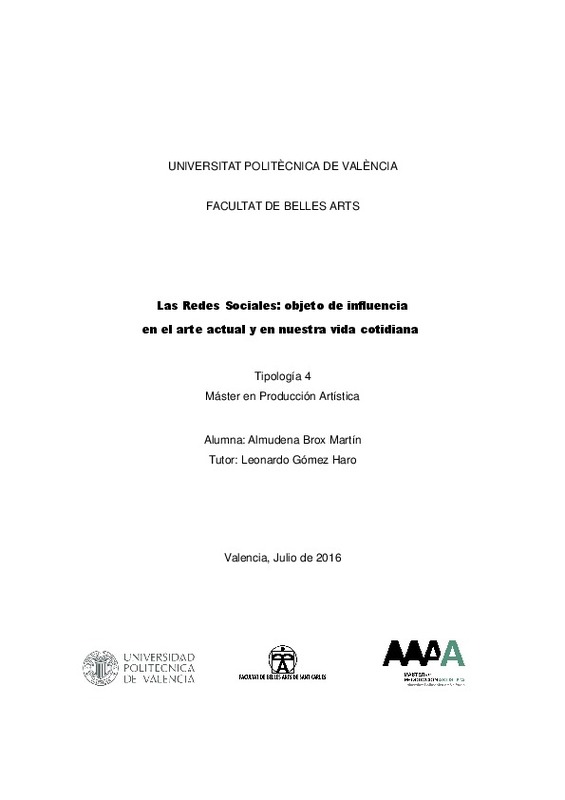JavaScript is disabled for your browser. Some features of this site may not work without it.
Buscar en RiuNet
Listar
Mi cuenta
Estadísticas
Ayuda RiuNet
Admin. UPV
LAS REDES SOCIALES: OBJETO DE INFLUENCIA EN EL ARTE ACTUAL Y EN LA VIDA COTIDIANA
Mostrar el registro sencillo del ítem
Ficheros en el ítem
| dc.contributor.advisor | Gómez Haro, Leonardo
|
es_ES |
| dc.contributor.author | Brox Martín, Almudena
|
es_ES |
| dc.date.accessioned | 2016-12-21T12:05:51Z | |
| dc.date.available | 2016-12-21T12:05:51Z | |
| dc.date.created | 2016-09-13 | |
| dc.date.issued | 2016-12-21 | es_ES |
| dc.identifier.uri | http://hdl.handle.net/10251/75547 | |
| dc.description.abstract | [EN] Back in the 90s the Internet started expanding worlwide. Since then, society has been inmerse in a continued change due to new technologies and our own dependency on mobile devices. More than 46% of the worldwide population are Internet users, whereas almost a 68% of the same, belongs, at least, to a social network. We are always exposed to society because of our web connection. Leaving aside the privacy problem, this issue has brought the posibility of creating or making up a 'digital alter ego' that shows just how we would like to be. In this essay we will think over the consecuences of the concept displayed previously as well as new technologies in our everyday life. This situation is meant to be represented through phtographic series including specs of irony and surprise elements. | es_ES |
| dc.description.abstract | [ES] En la década de los 90 del siglo pasado, Internet comenzó a expandirse de manera global. Desde entonces, la sociedad se ha visto inmersa en un cambio continuado debido a las nuevas tecnologías y nuestra respectiva dependencia hacia los dispositivos móviles. Más del 46% de la población mundial es usuaria de Internet, mientras que casi el 68% de los mismos, pertenece, al menos, a una red social. Estamos sometidos a un exceso de exposición pública debido a nuestra conexión a la red. Dejando a un lado el problema de la privacidad, este hecho ha traído consigo la posibilidad de crear o inventar un 'alter ego digital' que nos muestre tal y como querríamos ser. En este trabajo vamos a reflexionar sobre las consecuencias de ese tipo de autorrepresentación y del abuso de las redes sociales en nuestra vida cotidiana. Esta situación se pretende representar mediante una serie de fotografías incorporando en ellas pequeños matices de ironía y elementos sorpresa. | es_ES |
| dc.format.extent | 98 | es_ES |
| dc.language | Español | es_ES |
| dc.publisher | Universitat Politècnica de València | es_ES |
| dc.rights | Reserva de todos los derechos | es_ES |
| dc.subject | Redes sociales | es_ES |
| dc.subject | Sociedad | es_ES |
| dc.subject | Arte | es_ES |
| dc.subject | Cotidianidad | es_ES |
| dc.subject | Social media | es_ES |
| dc.subject | Alter ego | es_ES |
| dc.subject.classification | ESCULTURA | es_ES |
| dc.subject.other | Máster Universitario en Producción Artística-Màster Universitari en Producció Artística | es_ES |
| dc.title | LAS REDES SOCIALES: OBJETO DE INFLUENCIA EN EL ARTE ACTUAL Y EN LA VIDA COTIDIANA | es_ES |
| dc.type | Tesis de máster | es_ES |
| dc.rights.accessRights | Abierto | es_ES |
| dc.contributor.affiliation | Universitat Politècnica de València. Departamento de Escultura - Departament d'Escultura | es_ES |
| dc.contributor.affiliation | Universitat Politècnica de València. Facultad de Bellas Artes - Facultat de Belles Arts | es_ES |
| dc.description.bibliographicCitation | Brox Martín, A. (2016). LAS REDES SOCIALES: OBJETO DE INFLUENCIA EN EL ARTE ACTUAL Y EN LA VIDA COTIDIANA. http://hdl.handle.net/10251/75547. | es_ES |
| dc.description.accrualMethod | TFGM | es_ES |
| dc.relation.pasarela | TFGM\50801 | es_ES |
Este ítem aparece en la(s) siguiente(s) colección(ones)
-
BBAA - Trabajos académicos [5086]
Facultad de Bellas Artes






